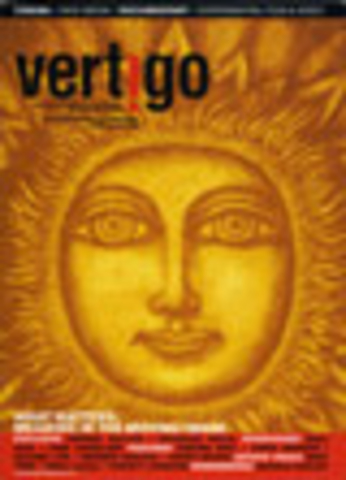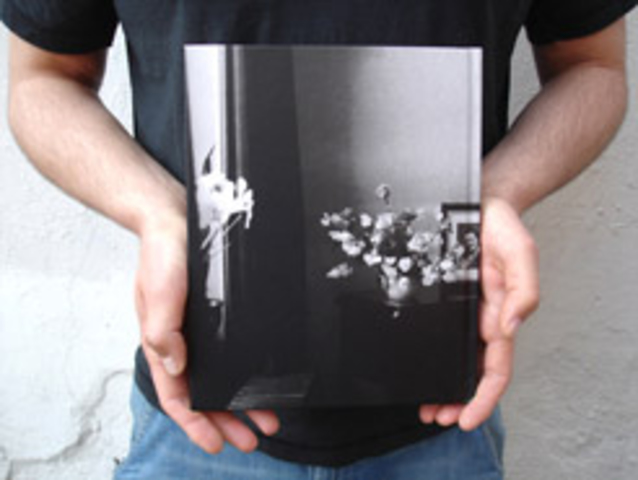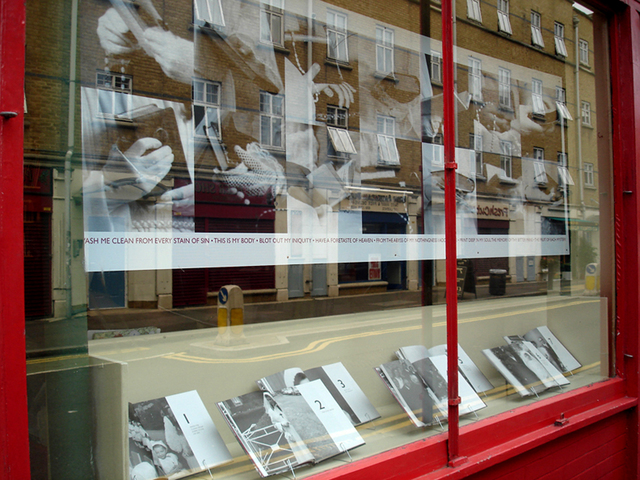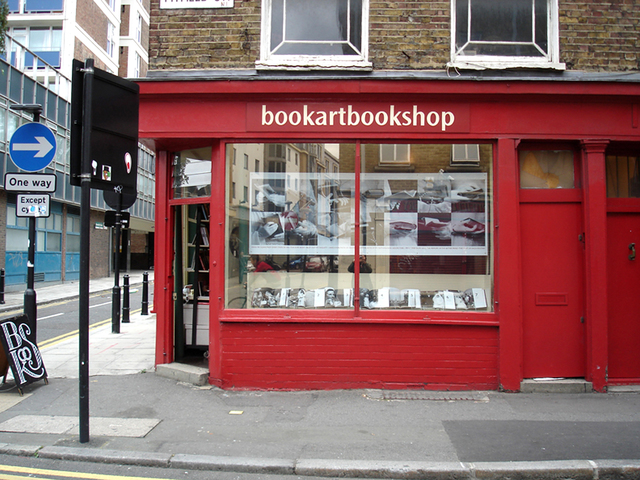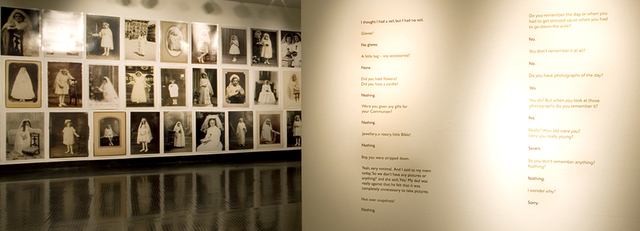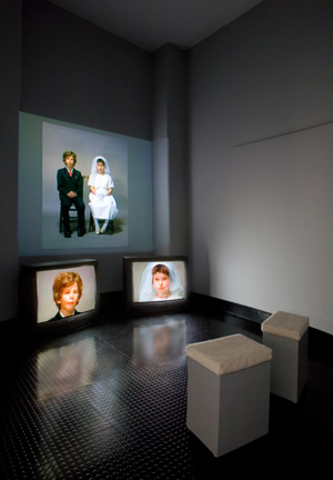This artist’s project represents four years of research (in part funded by the Arts and Humanities Research Council, the British Council, UCR California Museum of Photography, and UCCA, UK (now titled University for the Creative Arts). The work has developed across platforms and resulted in a number of linked pieces, which extend and expand Johnson’s interests in the interface between the archive, the book, the screen, and the museum.
The project has three distinct components: photographic site-specific installation, video triptych (projection/dual monitor work) and a published artist’s book distributed by Art Data, London. The Feast Project was previewed and launched in April 2007 in the Oculorium Gallery/Project Space at the UCR California Museum of Photography in the USA.
This work represents a convergence of three strands of inquiry: identity and the body, sites of memory, and the archive. The work as a whole aims to explore how the female body is socially and sexually constructed through transformative religious ritual; contemporary practices of intervention and the museum; collecting, re(collecting) and the relationship of artefact and memory; and the archive as a site of reclamation and narration. Through critical intervention, found material has been mobilised and the ’record’ put in question. The Feast Project operates as a set of interchanges between then and now, and reclaims a space for the reactivation of identity.
ARTIST’S BOOK
© 2007
Feast: Christy Johnson and 33 Confessors
Publication ISBN 978-1-870522-49-6
208 pages, b/w
Hardback Edition of 1,000
27.5 x 22 x 2 cm
Distribution: Art Data, London, UK
USA Book Launch and Artist’s Talk
28 April 2007
University of California Riverside, California Museum of Photography
UK Book Launch and window work "Missal"
20 September 2007, bookartbookshop, London
Feast: Christy Johnson and 33 Confessors is a performative proposition, where levels of enactment and re-enactment are in dialogue. Johnson is particularly interested in the document as a ritual space, and how the book form can become a site for discursive interplay.
She has created and drawn upon two distinct but related archives: found photographic imagery (the appropriated record) and contemporary spoken narratives whereby the past and present are brought into contact with each other. She has sought and collected hundreds of First Communion photographic images from various countries in the Americas and Europe. The anonymous portraits span the years 1877-1970. The bookwork features the photographs of prepubescent girls and explores their performative staging as 'virginal brides' for the public communal event, as well as the private photographic record. Alongside the visual archive, Johnson has conducted interviews with thirty-three women of differing social backgrounds and nationalities, ages and current involvement and position to religion. The edited text excerpts have been taken from the audio archive and juxtaposed with the found images in order to oppose, support, challenge, complement, contradict, subvert, or go beyond the meanings offered by the photographs themselves.
At the end of the work, three essays provide an interdisciplinary perspective on the project:
•Archival Memories: Between History and Experience (pp.182-89) Margherita Sprio, Lecturer and Scheme Director MA Art and Film, Department of Art History and Theory, University of Essex, UK
•Retrieval and Transmittal in a Fictive Photographic Experience (pp.190-97) Catherine Clinger, Visiting Professor of Art History, Department of Art and Art History, University of New Mexico, USA
•All in White for the Feast: Whiteness in the Christian Imaginary (pp.198-205) Jenny Daggers, Senior Lecturer in Theology and Religious Studies, Liverpool Hope University, UK
PHOTOGRAPHIC INSTALLATION
Oculorium Gallery
UCR/ California Museum of Photography, USA
Curated by Ciara Ennis
Feast: Christy Johnson and 33 Confessors
108 - 92 h x 61 w cm Lambda prints on Fugi archival paper
This floor to ceiling installation plundered the Feast archive, a depository of more than 400 found First Communion commemorative pictures from Europe and the Americas (1877-1970). A selection of 108 images enlarged and printed in colour (digital photographic Lambda prints) were presented in a three-row grid format on four walls that literally enveloped and surrounded the viewer - an army of pre-teen girls dressed in white. The anonymous photographic portraits explore and critique the initiatory performance of gender in ritual contexts (both sacred and secular), particularly addressing notions of purity and contamination. These monumentalised images become celebratory markers of an emergent prepubescent sexuality and desire. The fetishised ‘virginal bride’ motif once safely and happily in place, now reaches the challenging excesses of the fantastically bizarre. The size is a renunciation of where these photographs were originally placed, and the spectator confronted by a re-viewing. The sheer scale of the work exposes the physical nature of the First Communion event (both in the church and photographer’s studio) and sets out to deconstruct this important symbolic moment. Female sexuality is not located in a comfortable place … it is not clear where it is … it is not fixed. Confronting the images, two voices emerge in dialogue (wall texts) where amnesia and sharp recall explore the flux of denial and excess.
VIDEO INSTALLATION
Project Space
UCR/ California Museum of Photography, USA
Curated by Ciara Ennis
The Set
Video triptych with continuous sound (projection/two 382 cm monitors)& prayer cushion seating
32 minute, synchronized loop (5 x 5 minutes sequences)
This installation explores the authorial nature of the First Communion rituals - rote performances in the Church move seamlessly to mock performances in the studio. The Set draws on the artifice of the recorded climatic moment (fixed image). This video work is a continuous re-enactment of five photographic portraits drawn from the Feast archive, and points to the absent, unseen event that is re-done (staged) for the photographer. The representational conventions that are to be adhered to (as with wedding photography) are exposed simply through a reflexive approach where the children hold their performances in the anticipation of the release.
Gender as performance is explored in terms of how boys and girls are expected to behave. Being good and acting as you are told breaks down in each of the five sequences with each child monitoring the other. The sound of a cough, sneeze, whisper or movement of the body reverberates in the studio, breaking and punctuating the monotonous real-time action.

